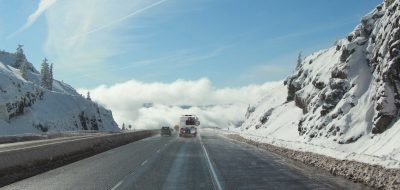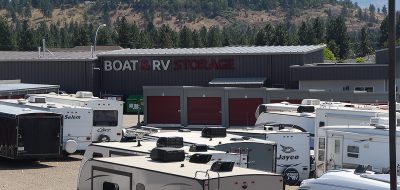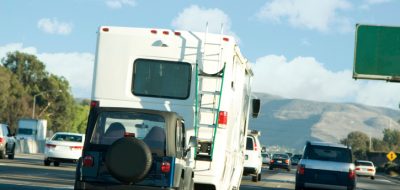 Even though most RV’s will never see winter weather while travelling, they are exposed periodically to bad and possibly violent weather. High gusting winds, torrential rains, driving hail and thunderous lightning bolts have all been experienced at one time by many of us. The fear of visible or embedded tornados and like-cyclonic disturbances is real and RV’s are particularly vulnerable. Almost all RV’s have a relatively high center of gravity and a poor vertical body structure to weight ratio. In other words, they can be adversely affected by winds.
Even though most RV’s will never see winter weather while travelling, they are exposed periodically to bad and possibly violent weather. High gusting winds, torrential rains, driving hail and thunderous lightning bolts have all been experienced at one time by many of us. The fear of visible or embedded tornados and like-cyclonic disturbances is real and RV’s are particularly vulnerable. Almost all RV’s have a relatively high center of gravity and a poor vertical body structure to weight ratio. In other words, they can be adversely affected by winds.
So, how do we deal with these trailers and motor homes when faced with an impeding storm on the open road? Of course, the easiest way, depending on the storm’s severity, is to cancel that day’s travel. But, many times you are already on the road, and it develops without warning. Let’s look at each element and the best strategy to adopt.
Wind – Can be an issue even on an otherwise nice day. A fast moving front or a steep pressure variation can produce substantially strong winds. Also geographical terrain, such as mountainous areas, can also deliver unexpected high winds and gusts. The affect of these winds on an RV can cause difficulty in maintaining its lane when running down a road or highway. This occurs when the wind speed is in the high twenties to the mid forties, depending on the size and weight of the vehicle. Wind gusts, as opposed to a steady wind state, can amplify the problem greatly. There are many accidents that are a result of driving in high wind conditions. These range from damaging a mirror from striking a passing truck to leaving the road due to loss of control.
Know your vehicle and control level in windy conditions. If you are driving with white knuckles or become nervous, you have passed your RV’s comfort level. Slow it down. As a general rule, I reduce speed by 10% when wind conditions are between 15 and 20 MPH and additionally a further 10% for every 10 MPH over 20. Never however, on a clear day, albeit windy, drive at a speed less than the minimum posted. If such a speed is warranted due to wind, it is time to stop. Winds approaching 50 MPH can cause dangerous driving conditions, and even more so if it is also gusty. In high winds or when you are out of your comfort level, either stop for the day or re-route to a slower road where you can drive with full lane control. In many cases driving or towing an RV in winds at or above 50 MPH may endanger both property and safety of yourself, your passengers and those in the immediate area. Remember, you might be able to hang onto it, but can that panel truck passing you?
Can RV’s blow over? Yes, all RV’s are capable of being upset by the wind force. Fortunately, in general, it takes a considerable wind force, far more than you would think to flip a trailer or motor home. Of course there are many factors that vary the wind speed required to cause this to a given vehicle.
 Heavy Torrential Rain – Heavy downpours can present a challenge. The faster you are travelling the worse the affect will be. Windshield wipers, in many cases, can not remove the sheets of water quick enough. Additionally, forward visibility is greatly reduced making it difficult to see the road surface and other vehicles, both of which are important to observe. It is important to watch for puddle build up to avoid possible loss of control in a deep water body, and other vehicles that are running ahead and beside you. Careful observation of smaller vehicles, like cars, is important. As you may be sitting much higher in your tow vehicle or motor home, you are impeded far less by the ground spray. This ground spray is caused by the rain drops bouncing off the road surface creating far lower visibility for several feet above the road. For this reason, be prepared for these vehicles to slow abruptly. This can be deceiving if you are viewing them from a high class A coach. They may appear to be slowing too much. This is due to their visibility being far less than yours as your view is somewhat higher above the road. During any rain event be sure to turn on your headlights, even if your vehicle is equipped with daytime running lights. Tire spray can obscure the rear of your rig, and the taillights will help other drivers see you.
Heavy Torrential Rain – Heavy downpours can present a challenge. The faster you are travelling the worse the affect will be. Windshield wipers, in many cases, can not remove the sheets of water quick enough. Additionally, forward visibility is greatly reduced making it difficult to see the road surface and other vehicles, both of which are important to observe. It is important to watch for puddle build up to avoid possible loss of control in a deep water body, and other vehicles that are running ahead and beside you. Careful observation of smaller vehicles, like cars, is important. As you may be sitting much higher in your tow vehicle or motor home, you are impeded far less by the ground spray. This ground spray is caused by the rain drops bouncing off the road surface creating far lower visibility for several feet above the road. For this reason, be prepared for these vehicles to slow abruptly. This can be deceiving if you are viewing them from a high class A coach. They may appear to be slowing too much. This is due to their visibility being far less than yours as your view is somewhat higher above the road. During any rain event be sure to turn on your headlights, even if your vehicle is equipped with daytime running lights. Tire spray can obscure the rear of your rig, and the taillights will help other drivers see you.
During any heavy downpour, it is wise to pull over and wait it out. This however, is difficult with a large vehicle or vehicle combination. Avoid pulling to the side or shoulder of a highway unless absolutely necessary. This area is far too dangerous as trucks and cars pass closely by. A rest stop or other large area is ideal. These heavy precipitations usually are very short lived, so you can soon be on the road again.

Lightning – Lightning can be dangerous, even while you are in your RV, driving or stopped. During lightning storms avoid contact with items that are grounded to the chassis, such as door handles or seat belt anchors. In case of a vehicle strike, these may become conductors for the high voltage discharge. If you are able to stop during an electrical storm, do not park near tall trees or telephone poles for fear they are brought down on your rig.
The speed of sound travels at roughly 1200 feet per second, this varies slightly depending on humidity and temperature. Therefore, you can calculate about how far the current lightning is from you by counting the seconds between, seeing the flash, and hearing the thunder. Dividing the number of seconds by 5 will give you an idea of the distance it is from you in miles. Remember though, if you are travelling at 60 miles per hour, you may be shortening that distance at the rate of 1 mile per minute.
These are just some of the thoughts of driving and dealing with common weather events. Next week, we will look at the chance encounter of a potential violet event, such as a tornado. We will examine how to possibly spot early signs of an oncoming tornado and how best to deal with it while driving.
With a Storm Safe Forecast – Lug_Nut – Peter Mercer






Pingback: Driving an RV in High Winds | RVing Here and There
Lug_Nut
Dago Trojan, Great points. The NOAA Weather Radio is a great idea and certainly within everyones budget. Thanks for your expert advice and for your paticipation on this topic.
Dago Trojan
The article states, “Of course, the easiest way, depending on the storm’s severity, is to cancel that day’s travel. But, many times you are already on the road, and it develops without warning.”
In my humble opinion, there’s no excuse for getting caught “without warning” with today’s technology. The simplest and fastest way to get weather warnings is with a NOAA Weather Radio. With seven dedicated channels, you can tune into local National Weather Service forecast offices. Alarm features will even wake you up in the middle of the night if a warning is issued. For a relatively low-cost investment — many portable units start around $35 — you can be forwarned instead of forlorn.
I also recommend your readers visit http://www.weather.gov, the National Weather Service’s website, which has some great weather safety tips.
Full disclosure — I’m a former National Weather Service public affairs officer — I’ve seen these things save lives. I won’t go on a trip in even the balmiest weather without my NOAA Weather Radio.
Lug_Nut
B Stone, Glad you found the article of interest. Your experience and advice are appreciated. Thank you for sharing it with us and for your great input.
B Stone
Good article. As I was reading it, I was thinking about something I was told to do when I first started driving ‘semi-truck’ in 1980’s – now there’s a long trailer with a high profile – and these two pieces of advice I received helped me control my travel trailer this winter in 50mph gusts across Wyoming, and a blizzard while heading east on I-70 in Kansas. 1) Don’t do anything sudden, and 2) the tractor (in this case my pickup) pulls the trailer. If you find your trailer is starting to fishtail, just ease down on the gas pedal (nothing sudden) and pull it back around, then slow down gradually when you can; but the best piece of advice, however, is get off the road and find a safe place to weather the storm.
I’m retired now, but still using the advice I received all those years ago, and it kept me safe in two very bad situations on my trip from Washington State to Oklahoma.
Lug_Nut
Bob Bruce, I’m pleased to hear you found the article of interest. I am alway happy to see people commenting and scoring the pieces. A part from hits, it’s the only measure one has to know if they are well taken.
Interestingly you mentioned “Proper loading”, a very important point, and one that generally is forgot by many. You rig sounds very stable and thereby safe. Thank you for sharing your set up and experiences in windy conditions. Happy travels.
Bob Bruce
Lug_Nut:
This is the first time I’ve seen your column, and I find it an interesting one to read. It’s nice that you take the time to respond to your readers with your own tips and ideas. Thank you for that.
I really took note of the stories about driving in windy conditions. Now for my little story.
I live in the San Francisco area. There are eight major bridges in the area, all high enough that the wind can cause problems for large and/or tall vehicles. Close to home, driving across the Benicia – Martinez bridge can sometimes be a real hair-raising experience. When I bought my truck, I opted for one with dual rear wheels, and I’m glad of it. I have a 9 – 1/2 foot camper on it, and believe me, sometimes it feels like I’m driving a sailboat! I really do believe that having the four wheels across the back has helped my stability in situations where I would otherwise be in danger of flipping over.
A large UPS delivery truck (with four wheels, not six) was in front of me on the bridge one time in heavy winds, and I was fighting the steering wheel a good bit. The UPS driver really had his hands full, and he was probably close to a case of sea-sickness when he got across!
I’ve seen other tall campers mounted on pickup trucks with only four wheels and obviously overloaded rear suspensions, and really wondered at how the drivers could be anywhere near comfortable with their rigs, with all that bouncing and swaying going on.
I don’t consider myself to be an experienced long-haul driver. However, I think I can vouch for the safety of having a rig that’s properly loaded, with a vehicle that is built to handle the load, whether that vehicle is a truck with a slide-in camper, or a trailer, or a motorhome. I’ve seen too much evidence of improper loading or support along the side of the road.
Lug_Nut
Jack Irvine, I totally agree. The center of gravity must be as low as possible to protect you and your property. You displayed good thinking and action in the face of what may have been far worse than you experienced. Thank you for sharing your real life experience.
Jack Irvine
While the article is primarily about driving during severe weather, allow me to share an experience while camped in our fifth-wheel in a facility in Iowa a few years ago. The campground employees came around about 9:00 PM and told us that there was a severe weather warning. We decided to bring the slideouts in, reasoning that the center of gravity would thus be more over the center of the trailer. We also decided to hitch up the truck, since that would tend to lower the center of gravity. About 11:00 PM, the wind picked up, the lightning was a nearly continuous flicker in our vent covers, and the trailer began to shake significantly. This lasted for about one half hour, though at the time it probably seemed much longer. In the morning, there was no damage to our trailer, but a nearby travel trailer was tipped onto its extended slideout, with the bottom edge of the slide curled under. I concluded that if we have to confront severe weather in the future, we will do what we can to center of gravity as low and centered as possible.
Lug_Nut
Robert Ellis, Thanks for the great tip. Noithing beats advice from a real experience. Thank you for sharing your thoughts and reasoning with us.
Robert Ellis
I tried to outrun Hurrican Isabel in 2005. We made it from Myrtle Beach to Fayetteville, before being blown all over the place. My advice is if a storm is coming head to a truck stop. Get in line with all the big rigs. Once we got parked at the truckstop, riding out the storm was easy.
Lug_Nut
Paul ROberson, Thank you, I’m glad you enjoyed the article. I’m not aware of any product that would do what you are looking for. Replacing the fabric may be the best option. It is not that expensive and can be done by the owner. Thanks for your input.
Paul ROberson
Very good article! When the front edge of a slide-out awning starts to fray, is there a product that can be applied to restore the fabric but still be flexible enough to roll up (possibly like Kool Seal)?
Lug_Nut
Lynette Vance, Avoiding the need to drive on icy roads is certainly the best, however, if you have to, there are several things to keep in mind. Trailer brakes must be very lightly applied, if at all. Without experience at this it would be a nerve racking time. Chains are generally used for mountain passes, which you indicated were not on your route. Additionally, chains can not be used on some vehicles due to inadequate wheel well space. If you are not pressed by a timeframe, you can stay over somewhere if the road surface conditions are poor. That way you should be able to enjoy the trip. Good luck. Thank you for your input.
Lynette Vance
What about driving on snowy or icy roads, with a travel trailer? I have an equalizer hitch and a 4 wheel drive p.u. Do I need chains? I won’t be going over any passes, just south near the coast
Lug_Nut
Phil Schoner, Yes, the awnings are usually the first thing to get damaged in a wind event. Your safety, of course, is the most important thing. Thank you for your participation on this topic.
Phil Schoner
Yes, keep in mind that slide covers, as opposed to awnings, do not roll completely in against the RV. There is about 3-4 inches exposed between the rooler and the slide, and this area can be caught by a strong wind.
Lug_Nut
Phil Schoner, Many people experience issues with their awnings when driving in heavy winds. 60 MPH is a very high wind to travel in, especially if it is varying from gusts. I’ve never had an issues with my awnings when operating in a heavy wind, but I have had both my mirrors blow out. This requires stopping and moving them back in. They were torqued at the factory and still I pushed them out three times in one day. The relative wind was over one hundred miles per hour on the coach. Thank you for your valued input.
Phil Schoner
Last May I was driving west across Nebraska on I-80 when I encountered 60 MPH winds quartering into me from the northwest. After a few hours I decided to pull off into a rest area where I discovered a problem with my right side slide cover. The wind had pulled out my slide cover and tore the front area of the fabric. I replaced it that summer only to encounter high cross winds (maybe 30-40MPH from the east) heading south from Grand Teton NP in October. When I reached Rock Springs, I discovered that my drive side slide cover had been pulled out by the wind, but not torn.
So…. keep in mind that these slide covers are wound up on a spring loaded roll and high winds can unroll them.
Phil Schoner
Lug_Nut
Louie Almond, You are quite right, crossing some bridges can present wind issues. This is part of the geographic wind affect, even though it is a man-made passage. On many high bridges, like The Sunshine Skyway on I275 south of St. Petersburg, Florida, warnings are posted when high cross winds may be experienced. Thank you for bring up that point and for your participation on this topic.
Louie Almond
Lug_nut: You didn’t mention elevated highway bridges, such as over a wide river. A class A is quite a bit lighter than even an empty tractor trailer.. A bridge such as the Geo. Wash bridge in NYC is high enough to give any RV driver serious concern at 30mph cross winds. The wind can be dangerous on the Tappenzee bridge at 25mph. Thanks for info, much appreciated.
Lug_Nut
Dave McCracken, Glad you found the article both interesting and timely. Thank you for your input.
Dave McCracken
The perfect artical for me, since I am traveling from Arizona to Iowa and back. Thanks for the info.
Lug_Nut
Alpenliter, Thank you for your kind words. I’m glad you found it of interest.
Lug_Nut
J Webber, Glad you found the article of interest. Also, great point on watching out for geographical wind changes. Over passes can briefly shadow a high wind and can also amplify the affect upon passing it. Thank you for bring that up. There are so many specific issues that can turn a wind event into a vehicle incident. Thank you for your valuable input on this topic.
Lug_Nut
Ralph A. Spanier, I’m glad you found this topic of interest. By far the best method to drive you coach or pull your trailer on icy/snowy roads is don’t, wait a day or two. But, if you must, or more likely, encounter it while on the road, slow down. Do not use any auxilary brakes or transmission downshifts. Increase and decrease speed at a very low rate. Slow for turns and bends at a speed that you can maintain a constant speed throughout the turn. Do not use your brakes unless absolutely necessary during a turn. If icy or hard packed snow covers the road and it starts to rain, get off the road as soon as possible and seek a place to hold up. If ice or a hard packed snow gets wet, the traction will go to near zero.
Now, the fact is, most motor homes and trailer combinations can be mastered in most winter driving conditions, as proven by thousands of trucks on that same road. But, they do it all the time and the majority of RVers do not. A day or two of white knuckled winter driving a year isn’t going to make you a master. Drive every day for an entire winter in those conditions and you will get used to it and be very comfortable.
So, for pretty well all RV owners, this is not going to happen and the far best approach is to try and avoid the exposure. Thank you for throwing out the question and for your great input.
Lug_Nut
Kathy Dillenbeck, Glad you enjoyed the article. Yes, various colors and types of sunglasses can have a positive affect on vision in some daylight conditions. There is a yellow snow type that can really help if driving in snowy conditions on a cloudy day. On cloudy days it can be very difficult to see drifts on the roadway due to lack of shadow. The yellow amplifies the shadow for a more actual view. Thank you for bring that up. The sharing of these types of experiences can help us all. Thanks for your great input.
Lug_Nut
Jonathan D. Olenick, Good advice if you are able to postion in such a manner. If, however, you are caught in a tornado, as will be discussed next week, it is not possible. Jacks down of jacks up?
Jacks down: Vehicle may be slightly higher and track width reduced. While less intital rocking would be experienced both of these may contribute to increasing the roll risk.
Jacks up: The tires and sprung suspension would exibit a heavy rocking motion. This motion would do two things, first it would slightly spill some of the wind pressure and secondly would continue to challenge the center of gravity.
The most secure configuration would probably be as follows.
A Spring Sprung Class A: Jacks down and just touching the ground surface. No lift.
An Air Sprung Class A: Aired down to maximum. Jacks down and just touching the groud surface. No lift.
Thanks for the great question and your input.
Lug_Nut
Roger Struthers, There really is no specific wind speed that one could put a number on for a “Class A” as there are many different makes, models, configurations and loading that have varied center of gravities. But, in my estimation, it may well be 100 MPH or better. Thank you for taking the time to comment.
Lug_Nut
Mel, I’m glad you found the article of interest. You are quite right, blowing sand can present a whole new weather event that can be very stressful and dangerous. Thank you for bring that up and for your valued input.
Lug_Nut
John de Vries, Actually, I am from Canada and have also experienced real winter driving in a motor home. However, you and I, and the rest of the northern folk, don’t make up even close to the majority, hence the words “Most RVers” Thanks for your participation on this topic.
Alpenliter
Thanks Lugnut! Good Stuff.
J Webber
great advice, but a couple of other points: when driving in a cross wind be very careful around underpasses and groups of trees, anything that might block the wind for a short time. Another idea for heavy rain is to put the flashing lights on, they are brighter than the tail lights and flashing is much more noticable, espically from behind. And don’t forget getting off an interstate at any exit, it is much easier to find a place to park.
John
Ralph A. Spanier
Excellent advice!
Do you have any advice for snow/ice conditions? We live in Alberta and frequently encounter both snow and ice during the first two days of a winter trip in search of continuous warm and frost-free weather.
Kathy Dillenbeck
Great article! A few weeks ago I received an email suggesting that wearing sunglasses while driving in the rain or snow will virtually eliminate seeing the raindrops or snowflakes. Since I live in Florida, I haven’t tested driving in the snow, but it sure works in the rain.
Jonathan D. Olenick
Your RV is designed to have a strong wind from dead ahead, ie driving 60-70 mph causes a 60-70 mph head wind. Therefore when stopped due to very strong winds, if at all possible head directly into the wind, your windshield may suffer, but your chance of other severe dammage is reduced. Next best orientation would be back end into the wind. Worts position is broadside to the wind.
Question, are you more stable on your tires and suspension, or on your leveling jacks????
Roger Struthers
I have wondered what is the windspeed to topple a Class A rv? I have driven in 40 mph cross winds and that seems to be close to the max. Has anyone acually tested this? I hope it’s closer to 70 or 80 mph.
Mel
Very good article and good advice. You did not mention Blowing Dust. I have been in severe dust storms in Arizona and Texas. I was in a bad one between El Paso TX and Junction TX for 200 Miles the visibility was so bad that the Texas Highway patroll were escourting vehicles at 20 MPH through El Paso.
Mel
John de Vries
hi Lug-Nut,
good and useful comments about hazardous weather conditions. But you write
Even though most RV’s will never see winter weather while travelling,
which makes me suspect that you are not from the Northern states or from Canada. When we drive from Ottawa, Ontario, to Florida, we frequently encounter winter conditions (such as: snow-covered interstates in New York and Pennsylvania, sleet, ice or freezing rain in either of those states, but also occasionally further South). I doubt that we are the only Canadians travelling South in an RV who encounter this.
Bye for now,
John de Vries